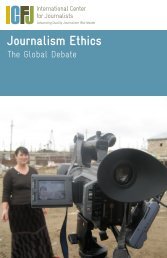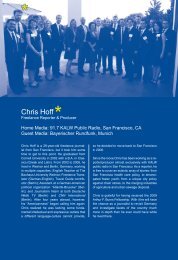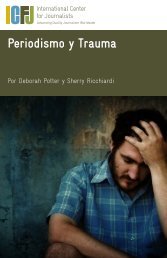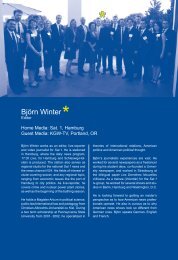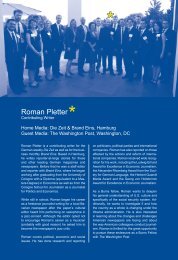Disaster and Crisis Coverage - International News Safety Institute
Disaster and Crisis Coverage - International News Safety Institute
Disaster and Crisis Coverage - International News Safety Institute
You also want an ePaper? Increase the reach of your titles
YUMPU automatically turns print PDFs into web optimized ePapers that Google loves.
www.journalistsatrisk.org/safety_tips.php?CID=4) <strong>and</strong> the <strong>International</strong> <strong>News</strong><br />
<strong>Safety</strong> <strong>Institute</strong> (http://www.newssafety.org).<br />
Stay in touch<br />
Journalists in the field should make sure at least one person, usually a<br />
supervising editor, knows where they are at all times, who they are meeting with,<br />
<strong>and</strong> when they are expected to return. That person should have a list of<br />
personal emergency contacts <strong>and</strong> should know what to do if the journalist does<br />
not check in as expected.<br />
Minimize risk<br />
Stay with a partner. WNYC radio reporters Beth Fertig <strong>and</strong> Marianne McCune<br />
worked as a team covering the 9/11 attacks in New York City—keeping each<br />
other calm, finding eyewitnesses to interview. As disaster experts say, calm<br />
reduces risk.<br />
Get close (but stay safe)<br />
If journalists are being prevented from getting close to a disaster scene, figure<br />
out why. Are authorities keeping journalists out to save their lives, or “just<br />
because?” If it’s “just because,” find a way in. Flak jackets provide some<br />
protection in dangerous situations. Wear them, if available. Gas masks or<br />
protective suits are not designed to let a person stay at a hazardous scene.<br />
Experts say they are mostly useful for getting away alive. Because gases are<br />
heavier than air, avoid low-lying areas when covering a chemical spill or attack.<br />
Stay upwind.<br />
Avoid becoming a target<br />
If covering riots or violence, don’t go in with a marked news vehicle <strong>and</strong> keep TV<br />
lights off. Don’t interfere with law enforcement or rescue efforts.<br />
Pay attention<br />
Journalists should be aware of their surroundings <strong>and</strong> stay as portable as<br />
possible, so they can move quickly, if necessary. Be alert for unusual sounds,<br />
such as loud pops, <strong>and</strong> for unexpected sights—does someone appear to be in<br />
the wrong place or doing something unusual? If reporters hear gas or vapor<br />
escaping, they are probably too close to a scene. If they can smell a pungent<br />
odor, they may have been exposed to a chemical hazard <strong>and</strong> may be<br />
contaminated; they should leave immediately. The U.S. National Academies has<br />
concise fact sheets on biological, chemical, nuclear <strong>and</strong> radiological threats that<br />
reporters may want to print out <strong>and</strong> carry with them. (http://www.nae.edu/nae/<br />
pubundcom.nsf/weblinks/CGOZ-642P3W?OpenDocument)<br />
<strong>International</strong> Center for Journalists<br />
34



